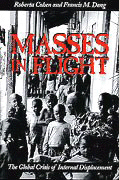INTRODUCTION
In recent years, studies have been carried out, campaigns have been launched, and considerable thought has gone into how to resolve protracted refugee situations.[1] Academics and practitioners alike have grappled with the difficulties in finding solutions for refugees who have lived in camps for far too long.
While millions of IDPs, like refugees, have languished in camps for extended periods of time, protracted IDP situations have received virtually no attention from academic researchers. There are important similarities in the impact of prolonged displacement on the lives of IDPs and refugees, but there are also significant differences in their situations – particularly when it comes to solutions. This paper begins by suggesting a definition for protracted IDP situations and then discusses similarities and differences between protracted refugee and IDP situations. The study then examines three case studies of protracted internal displacement: Colombia, Georgia, and Darfur with a particular focus on the role of IDPs in negotiations to resolve the conflict, the involvement of key international actors in influencing the situation on the ground and the possibilities for durable solutions. While return is often the desired solution for both IDPs and political actors, the paper argues that local integration and return should not be seen as mutually exclusive alternatives. IDPs can be encouraged to build new lives elsewhere without having to give up the possibility of eventual return when conditions warrant.
[1] See for example, Loescher and Milner 2005; Loescher, Newman, and Troeller forthcoming; Smith 2004; Milner 2005; Crisp 2003; UNHCR 2004b; UNHCR 2004d; UNHCR 2006a: 105-127.

